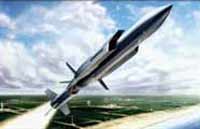India places two-billion-dollar order for Russian missiles
Designers of the Indo-Russian supersonic cruise missile BrahMos hope to receive an order for the production of missiles for submarines of the Indian Navy, the chairman of board of directors of the joint-venture, Alexander Dergachev said.

“The missiles will be made for submarines of the Indian Navy. The nearest order is seven submarines. We do not know yet when exactly it is going to happen. I hope soon,” the official said at a press conference devoted to ten years since the establishment of the joint venture BrahMos.
Dergachev said that India would announce the tender for seven submarines in the nearest future. Submarine-makers from Russia and other countries of the world will participate in the tender. The tender stipulates BrahMos cruise missiles for the submarines.
Sivathanu Pilai, the chief executive of the Indo-Russian aerospace joint venture BrahMos, stated that India already had a contract for the production of six submarines on the base of Scorpio project (France).
India’s order to the joint enterprise is evaluate at $2 billion, Pilai said. BrahMos makes land and sea-based supersonic cruise missiles for the Indian Armed Forces.
BrahMos Aerospace is a joint Indo-Russian venture established in 1998 to design, develop, produce and market a unique supersonic cruise missile.
BrahMos is a supersonic cruise missile that can be launched from submarines, ships, aircraft or land. The acronym BrahMos is perceived as the confluence of the two nations represented by two great rivers, the Brahmaputra of India and the Moskva of Russia. It is a joint venture between India's Defense Research and Development Organization and Russia's NPO Mashinostroeyenia who have together formed the BrahMos Corp. Propulsion is based on the Russian Yakhont missile, and guidance has been developed by BrahMos Corp. At speeds of Mach 2.5 to 2.8, is the world's fastest cruise missile. It is about three and a half times faster than the American subsonic Harpoon cruise missile.
Between late 2004 and early 2008, the missile has undergone several tests from variety of platforms including a land based test from Pokhran desert, in which the S maneuver at Mach 2.8 was demonstrated for the Indian Army and a launch in which the land attack capability from sea was demonstrated.
BrahMos claims to have the capability of attacking surface targets as low as 10 meters in altitude. It can gain a speed of Mach 2.8, and has a maximum range of 290 km. The ship-launched and land-based missiles can carry a 200 kg warhead, whereas the aircraft-launched variant (BrahMos A) can carry a 300 kg warhead. It has a two-stage propulsion system, with a solid-propellant rocket for initial acceleration and a liquid-fueled ramjet responsible for sustained supersonic cruise. Air-breathing ramjet propulsion is much more fuel-efficient than rocket propulsion, giving the BrahMos a longer range than a pure rocket-powered missile would achieve.
The high speed of the BrahMos likely gives it better target-penetration characteristics than lighter subsonic cruise-missiles such as the Tomahawk. Being twice as heavy and almost four times faster than the Tomahawk, the BrahMos has almost 32 times the initial kinetic energy of a Tomahawk missile (although it pays for this by having only 3/5 the payload and a fraction of the range despite weighting twice as much, suggesting a different tactical paradigm).
Although BrahMos is primarily an anti-ship missile, it can also engage land based targets. It can be launched either in a vertical or inclined position and is capable of covering targets over a 360 degree horizon. The BrahMos missile has an identical configuration for land, sea, and sub-sea platforms. The air-launched version has a smaller booster and additional tail fins for added stability during launch. The BrahMos is currently being configured for aerial deployment with the Su-30MKI as its carrier.
Subscribe to Pravda.Ru Telegram channel, Facebook, RSS!




